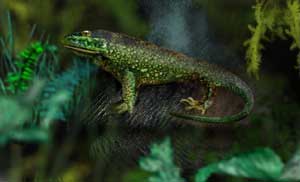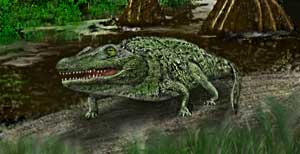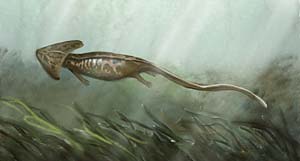Devonian
Times
390
Million Years Ago
Animals begin
to resemble amphibians |
Fish Develop
Lungs and Walk on Land
The first fishes
to develop lungs were the lobe-finned fishes called Crossopterygians
and the lungfishes called Dipnoans.
The Crossopterygians are considered to be the ancestors to
land animals.
The Crossopterygians had evolved "land animal-like features":
· A more impervious skeleton
· Enhanced nostril development
· Leg-like bone features in their fins.
One type of Crossopterygian was Eusthenopteron.
Eusthenopteron was one of the first fishes to venture out onto
land. This occurred toward the end of the Devonian Period.
Animals like Eusthenopteron may have come out unto land for
the following reasons:
· Their ponds dried out during a draught
and they had to cross over land to find a new pond.
· They needed to find new food sources.
Eusthenopteron
.jpg)
The
above illustration was provided by:
The Museum of Natural History
Miguasha Park
World Heritage Site
Web Sites: http://www.sepaq.com
http://www.wcmc.org.uk/protected_areas/data/wh/miguasha.html
http://www.unesco.org//whc/sites/686.htm
Primitive Amphibians
Develop True Legs and Spend Extended Time on Land
Ichthyostega
lived during the Late Devonian Times. Ichthyostega was a cross
between a fish and an amphibian. Ichthyostega had legs and
walked and was a true tetrapod. With true legs, it could live on land
for extended periods.
Primitive amphibians like Ichthyostega differed from animals
like Crossopterygians (picture above) in the following ways:
· Although the Crossopterygians had lungs, they used
their gills as the primary means of acquiring oxygen. Conversely,
Ichthyostega used lungs as the primary
means of getting oxygen.
· The primitive amphibians like Ichthyostega had a special
kind of skin that helped them retain bodily fluids and
deter desiccation. Crossopterygians did not have this feature.
· The skeletons of animals like Ichthyostega had grown
stronger than those of Crossopterygians. Stronger
skeletons allowed the primitive amphibians to live more
comfortably with the increased gravity on land.
· The Crossopterygians used their bodies and tails to
move about while using their fins for balance. Animals like Ichthyostega
used their limbs for locomotion and their
tails for balance.
Advantage for amphibians living on land:
less competition for food, avoidance of large predatory fishes.
Disadvantages for amphibians living on land:
Amphibians have gas-permeable skin to aid their inefficient lungs.
This skin must be kept moist.
They must have water to reproduce, Water is needed for the external
fertilization that is characteristic of amphibians.
Amphibian jelly-like eggs can not survive out of water.
Ichthyostega

|
Carboniferous
Period & Permian Period
300,000,000
- 250,000,000 Years Ago
Ampibians
|
Amphibians become
adapted to life on land.
· Amphibian
nostrils became increasingly functional for breathing air.
· Amphibians evolved "hands" and "feet"
with five digits.
· Amphibian tales become reduced in size.
· Amphibian backbones grow stronger. This enables amphibian
bodies to grow bigger.
· Amphibians obtain eardrums.
Rhachitomes was the dominant amphibian group of the Permian
Period.
The Rhachitomes group was very diversified.
They varied greatly in size, body structure, and lifestyle.
Eryops was a Rhachitome. Eryops had an
incredibly strong skeleton. It also had heavy armored scales to protect
itself from predators. Eryops mostly ate fish, but probably
preyed upon land living animals as well.
Eryops

|
300,000,000
- 200,000,000 Years Ago
Ampibians
|
Other
amphibians that lived during the Carboniferous and Permian times:
· Microsaurs
- small primitive amphibians that lived in undergrowth in swamps.
· Aistopods - small snake-like amphibians that had diminished
limb structure.
· Sauropleurs - elongated snake-like animals with no
legs
· Diplocaulus - a strange looking animal with a flattened
body. Its head grew increasingly flatter as it aged until it looked
like an arrow. This animal used it's strange head as a sort of underwater
wing. It had weak limbs. It spent most of its life on the bottom of
ponds and streams.
Diplocaulus was very common during this period. This amphibian
ate other small animals. They were probably preyed upon by fresh water
sharks, larger amphibians, and carnivorous reptiles.
Diplocaulus

|
325,000,000 - 250,000,000 years ago
Ampibians
& Reptiles
|
Amphibians start
to evolve into Reptiles:
Seymouria
lived during the Permian times. This animal was a connecting link between
reptiles and amphibians.
· Seymouria's skull was similar to an amphibian's. However
most of the rest of its skeleton resembled that of a reptile.
· Seymouria also had a horny epidermis of overlapping
scales.
Animals that lived
in the shallower waters evolved lungs and scales. Soon after; these
creatures evolved legs, shelled eggs, and the ability to breath through
nostrils with their mouths shut.
* The oldest shelled egg fossils are 280 million years old.
* The shelled egg's advantage is that it will not dry out when it is
outside of water.
Seymouria

|
Carboniferous
Period
325,000,000
years ago
Reptiles
|
Reptiles become
more abundant.
During this time period:
* Plants had become well established on land.
* Insects were abundant as well. (The first reptiles were insect eaters.)
* Oceans were receding which caused the competition for survival in
the seas to increase.
Facts:
Reptiles were the first true terrestrial vertebrates.
Reptiles were the first animals to lay shelled eggs.
These new animals - the reptiles - had evolved from amphibians who lay
jelly like eggs.
Although the first reptiles laid their shelled eggs on the land, they
were still mostly aquatic creatures.
* Advantages to laying eggs on the land:
1. Eggs laid on the land would have a better chance of staying where
the female laid them.
2. There may have been less predators on land to feed on the eggs.
3. Eggs laid on land could not be carried away by moving water.
Advantages that
reptiles had over amphibians:
1. Internal fertilization which led to the shelled egg mentioned above
2. Reptiles had more independence from water
3. Reptiles had thick impermeable skin
4. Reptiles had stronger limbs.
|